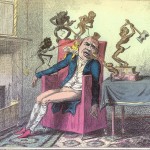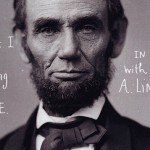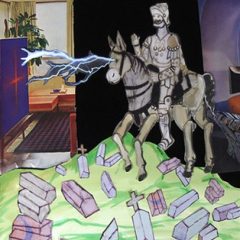
Joseph ben David, of Leipnick, scribe. Birkhat Hamazon and other blessings: manuscript. Darmstadt, 1732.
While I was at the Rosenbach, I also took a look at The Chosen, an exhibit of Philadelphia Hebraica that was pretty amazing, with books and pages and scrolls from as far back as the 11th century.
Among the items that stunned me were intricate micrographic marginalia, some of it used to create patterns. Micrographic writing is part of the Hebrew text tradition, and if you’re a fan of Jacob el Hanani, who has some work up right now at Gallery Joe, this is the place to look for his artistic roots.
I was also struck by how Christian artistic traditions from various countries shone through in Jewish texts. One of my favorite instances (I’m not sure in which text) was a lineup of Jewish men whose circular hats behind their heads looked like halos.
I also was entranced by a couple of Bibles with multiple translations side by side. My favorite language among the more expected ones like Latin and Spanish was Chaldean. Who knew the Chaldeans even had their own language???
I was there as a dabbler. But the exhibit has something for many levels of interest.

This printed Passover prayerbook, or hagadah, is perhaps best known for being the first to offer a map of the exodus from Egypt, shown here.
These highlights were listed by the press release:
* the first known illustration depicting a bar mitzvah (18th century)
* the oldest nearly complete Passover haggadah in existence (11 th century)
* a Torah scroll listing ‘the Eleven Commandments’
* the oldest Hebrew Bible in North America (1266)
* the first Hebrew prayer book written for popular use
* the first known illustrations of Passover matzahs in manuscript and printed books
* the first book written by a Muslim that was translated into Hebrew
* the first printed prayer book printed in Hebrew
* one of only six extant books bound in a Portuguese box-binding
* the first Protestant translation of the Bible directly from Hebrew into Latin (1534-35)
* the first translation of the Hebrew Bible into Spanish (1553)
* the first book published in what is now the United States (1640)
* the first depiction of a map of the Exodus from Egypt (1695)
* the first scientific illustration of a liquid-in-glass thermometer (1628-29)
But I was intrigued by other things, for the most part. So there’s lots to see here.
Many of these objects are on loan from the Center for Advanced Judaic Studies Library at the University of Pennsylvania, but there were a number of lenders, including several synagogues, universities and the Free Library of Philadelphia.
The exhibit was curated by the Rosenbach’s Judith Guston, with consulting curator David Stern, from Penn, who is actually someone I know!
The exhibit is up until Aug. 26.









